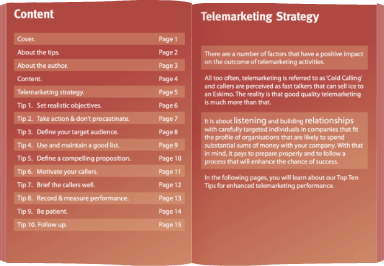I received a lot of positive feedback the last time I posted an article on my top 10 telemarketing tips that I felt it was time to do another. Below are a further 10 tips to ensure you get the most out of your telemarketing calling.
1. Take action
No time is perfect and the key is to generate impetus and momentum in your business. Successful business development requires effort and consistency. It’s also important to recognize that every business has a defined gestation period before sales leads and profit begins to flow. Hence, any telemarketing should commence in advance of the time when you want or need new sales to commence. After all, how often do you walk into a new business meeting and walk out with an order there and then?
The main thing is to avoid waiting for the perfect time. If sales growth is a concern, now is the time to take action. Don’t wait for the perfect literature to send out. Sadly, most beautifully crafted marketing brochures end up in the bin. We know that a strong website and social presence are increasingly important for lead generation. But if they aren’t 100%, don’t let that impede your progress. Make the changes by all means. But don’t let it stop you. Every business and market has its ups and downs. So don’t wait for your market or collateral to be perfect. Just make those calls.
2. Work on your proposition
How many competitors operate within your sector or area of business? The chances are that there are quite a few. And, it’s quite possible that they are offering similar services to yours if not identical. As a result, you need to think carefully about how to make your business and your services attractive to prospective clients. This is not just for telephone marketing but also across the board. We’d suggest that you consider what problems your business solves rather than what services you offer. For example, do you help to reduce costs, increase productivity, protect systems or resolve some other equally frustrating problem? Whatever it is, on the phone you have possibly one or two sentences at the most to grab a prospect’s attention. Try to make sure you use the few seconds you have to talk about them and their needs, not you and your services!
3. Define your target market
A good proposition to the wrong target company or individual will take you nowhere. However, an average proposition to someone that is looking for that kind of service may carry you through. Therefore, really put some extra time into defining what type of company would be most likely to use your services.
If you want to target pharmaceutical companies but have no pharma compliance experience, it could be tough to break into that sector. Hence, you need to work to your strengths. What areas does your company specialize in? What good work have you done in specific markets? What well-known clients have you got in particular areas? Do you have an innovative solution to a sector-wide problem? Are there a market or legislative drivers or changes that support the adoption of your services?
Ideally, select an industry that you understand rather than one with high barriers to entry. Once you have selected the sector, decide who the decision-maker is that you need to talk to. In a perfect world, you need to start as high up as possible since they hold the purse strings. However, if you can’t reach them, try to find someone with a problem that you can cure who could be your champion in the organization.
4. Do the work on list buying
A good list is worth its weight in gold. Once you’ve defined your sector and who you want to speak to, you need to select a quality list provider. Choose on reputation and relevance. Make sure that the list you purchase is updated and cleaned as regularly as possible. Ideally not less frequently than 6 months but 12 months is probably the norm. Also, ensure that the lists are screened for opt-outs on the CTPS (Corporate Telephone Preference Service). You don’t want to run into problems with data protection so ask the listing provider if they screen their list. If they don’t, you’ll need to screen the list. Either way, you need to screen for opt-outs every 28 days to comply with legislation.
Decide where the best list can be sourced. For example, if your target market is specialized, you may need a specialist list from an industry magazine or association.
If you can market to any industry then you can consider a more generic list from Experian or Dunn and Bradstreet. The key is to consider the following parameters and buy against these:
-
-
- Location — National or regional. Would you really go to the North of Scotland or South of England for a meeting? Restrict the location to where you will travel and where you can service.
- Sector — Select your preferred industries and most likely markets where you can be successful
- Size — Is your best work done with companies with more than 200 employees or smaller businesses? Do you need companies with a turnover of >£20m to justify your fees?
- Single or multi-site? – Do you want single-site companies at head office where decisions are made or can you speak to branch offices or retail shops where local decision-makers are located?
- Named individuals – Does the list supplier hold the names of the people you want? For example, if you need Facilities managers or Personnel directors these may not be available on traditional lists and this may force you into selecting an industry-specific list or do research on LinkedIn.
- Single or multi-use? — Companies often believe they will recycle the contacts and use them many times. The reality is that unless you’re planning multi-campaigns or consistent calling over a period of time, purchasing a single-use list is less costly. And don’t forget that with single-use, if the prospect asks you to call back, you can still do so under the terms of the agreement for the list.
- How many contacts? — You need enough data to maintain momentum in a telemarketing campaign. There’s nothing worse for a caller than over-calling the same records. Whilst you need to consider the amount of calling you’re doing to avoid wastage, don’t buy more than you need for the campaign. If you’re not doing a significant amount of calling, keep to the minimum order quantity and buy a new list when you need it. The fresher the data the better!
-
5. Brief and train your team well
When using telemarketers, the mushroom treatment doesn’t work. You can’t leave them alone in a dark room, feed them rubbish and hope they will generate the results. You need to brief them well. That doesn’t mean that they need to know the ins and outs of every technical aspect of your service. That’s what your sales team is there for. However, they do need to know why you’re unique, why a prospect should see you, why they should see you now, and what problems your service cures or helps.
It helps to provide a written briefing and to follow this up with a presentation to those making the calls after which they can ask questions. Don’t forget that ongoing communication is important, as your telemarketers will learn as they go and you’ll be able to help them quickly overcome any gaps in their knowledge.
6. Choose the right people
The key to good telemarketing is attitude and enthusiasm. This has to be focused but someone with a great attitude and passion for your services and outbound calling will outperform someone with huge technical knowledge of how your operation functions. Personality and the ability to build rapport are crucial. Studies show that only 7% of all human communication is related to what we say. Body language is the most important factor closely followed by tonality. Hence, over the phone, how you say it is almost more important than what you say.
As a consequence, choose people that are passionate. Make sure they listen more than they speak. Also, make sure that you match the telemarketers with the prospects you’re calling. If you’re calling the marketing director of Mars or Unilever, you don’t really want an 18-year-old student to make the call. Peer-to-peer communication is important in building rapport and therefore you want someone that will be able to get past the rottweiler gatekeeper. You don’t want a caller who freezes when faced with a heavy hitter posing tricky questions. That risks damaging your reputation forever with that prospect.
7. Be patient
Telemarketing isn’t a precise science. You shouldn’t necessarily expect results overnight. Sometimes campaigns fly right from the off. If you line up the factors we’ve discussed here, results should come more swiftly but success in telemarketing depends on any number of factors and ratios vary. These relate not least to:
-
-
- The economy and market situation including drivers and legislation
- The choice of the target market
- Level of competition (including price)
- Level of awareness of your company in the market
- Quality of your credentials and client testimonials (e.g. having produced for companies within their industry)
- Relevance of your services to the proposed target market
- Any relevant offers
- Timing
- Follow-up (e.g. calling them back in 6 months when they ask)
- Building momentum (i.e. doing enough calling to build up a head of steam)
-
8. Set realistic objectives
High-quality lead generation takes time. Not every prospect is looking for your services at the time of the call. Equally, your proposition needs to be attractive.
You also need to consider what level of new business meetings you and your team can handle alongside the ‘day job’.
Therefore, set your expectations accordingly and be realistic. If you’ve had someone in-house full time and they’ve only generated 4 appointments of debatable quality over 6 months, don’t expect 30 appointments per month using an outside company if you plan to allocate only 30 hours per month to the activity.
The key is setting objectives for what you can handle and what is consistent with your business status and proposition. For example, if you have something everyone wants and the credentials and client base to back this up, you will certainly achieve more than a start-up company with few clients and no experience.
The other aspect to consider is whether you want speculative meetings in addition to meetings with prospects that are looking right now? Our view is that speculative meetings are important as they allow you to unearth needs and to promote your services. They also build momentum for you. This assumes of course that the speculative meeting is with the right kind of company and someone that is a decision-maker. And they need to be receptive to your proposition even if they aren’t ready to move forward right now.
A good spread of speculative and warm meetings will help to build your mid-term pipeline
9. Follow-up – Follow-up – Follow-up – Follow-up
With telemarketing, you must be prepared to follow up all the way to the end. This means:
-
-
- Have written information available for prospects that want to see something visual by post. And make sure it is relevant and benefits-focused!
- Prepare a good email for those that want more information by email. A good body copy and simple pdf case study should do the trick
- Make sure emails and meeting confirmations go out promptly
- Don’t change the meeting time unless absolutely necessary
- Prepare in advance of the meeting. Review the prospect website at least and check them out on LinkedIn
- Plan your meeting. Don’t over-present. It’s much better to listen and understand that to try to dazzle by PowerPoint
- Agree on the next steps at the end of the meeting. Agree a time to call back or meet again
- Follow-up when you say you will and keep doing so until the lead either converts to business or it becomes clear that no business will be forthcoming. This could be a long gestation or short dependent on your type of business and also the cost of sale
- Make sure you work with your telemarketer to brief them on the outcome so the loop is closed and so they learn from your face to face experience
-
10. Build momentum
Things don’t happen overnight in business development. This is true regardless of which channel you use. Don’t expect instant results. You need to give it at least three months if not longer, to judge whether the caliber of meetings is appropriate. It could be that sales don’t flow for some time but you are seeing prospects you would not have seen otherwise and that could convert to business later.
It’s important to manage your time but momentum means regular follow-up calls post-meeting and then on a quarterly or bi-annual basis based on what you agree with the prospect. Make sure you plug this into an electronic task list or calendar. Ideally, this should be on your CRM. Remember that the follow-up calls represent your business development pipeline and this is one of the most valuable assets in your business.
Telemarketing is a potentially powerful means to generate a sales pipeline for your business. It stops inertia in terms of insufficient lead generation. However, you need to work the process and give it time to deliver. If you do, you’ll see the results in terms of momentum in your business and sales growth.
If you’d like to know how GSA Business Development can help generate growth for your business through telemarketing appointment setting or book one of our new business development strategy workshops, contact us now on 0845 658 8192 or use the form on this site.






